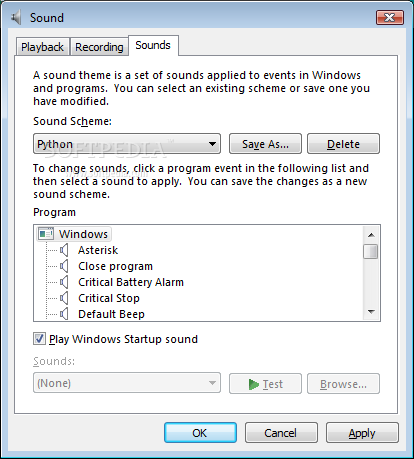

Hence, we are now able to do something like this: > sound(data, fs=4000) # The do note was recorded using a lower sampling frequency of 4000 Stream = p.open(format=pyaudio.paInt16, channels=1, rate=fs, input=True,Īrray = np.frombuffer(buffer, dtype='int16') When it comes to recording, the function below comes in handy: def record(duration=3, fs=8000): Stream = p.open(format=pyaudio.paInt16, channels=len(array.shape), rate=fs, output=True) Provided with this set of tools we can define the following function that allows us to play a numpy array of dtype=int16: import numpy as np Play audio by writing audio data to the stream using (), or read audio data from the stream using (). This sets up a pyaudio.Stream to play or record audio. To record or play audio, open a stream on the desired device with the desired audio parameters using (). To use PyAudio, first instantiate PyAudio using pyaudio.PyAudio(), which sets up the portaudio system. The main features outlined in its documentation are the following:
PLAY SOUND IN PYTHON INSTALL
In the case that it was recorded as a stereo sound signal it the shape of data would have been (8000, 2).įinally, in order to play or record audio, we can use the PyAudio package which can be installed by means of conda install pyaudio. The fact that the array only has one dimension means that 'do.wav' was a mono sound signal. wav file ($4000 Hz$ in this case) and a numpy array representing the data read with length 8000 which implies that the recording lasts $2s$. The wavfile.read() function returns both the sampling frequency of the. We can load it into Python as follows: > from scipy.io import wavfileĪrray(, dtype=int16) Your browser does not support the audio element.

For instance, given the following recording of the note Do, They are written in curly brackets with key - value pairs.The scipy.io.wavfile library allows us to deal with WAV files. Example: mysetĭictionary is a collection of key value pairs which is unordered, can be changed, and indexed. Set is a collection which is unordered and unindexed. Example: myTuple=("iPhone","Pixel","Samsung")īelow throws an error if you assign another value to tuple again. Tuple is a collection which is ordered and can not be changed. List is a collection which is ordered and can be changed. There are four types of collections in Python. Usually while is preferred when number of iterations are not known in advance. While is also used to iterate a set of statements based on a condition. Example: mylist=("Iphone","Pixel","Samsung") For:įor loop is used to iterate over arrays(list, tuple, set, dictionary) or strings. Indentation is very important in Python, make sure the indentation is followed correctly 2. When ever you want to perform a set of operations based on a condition IF-ELSE is used. It's is highly productive and efficient making it a very popular language. It is designed to be simple and easy like english language. It is very popular for web development and you can build almost anything like mobile apps, web apps, tools, data analytics, machine learning etc. Python is a very popular general-purpose programming language which was created by Guido van Rossum, and released in 1991. Following is a sample python program which takes name as input and print your name with hello. OneCompiler's python online editor supports stdin and users can give inputs to programs using the STDIN textbox under the I/O tab.
PLAY SOUND IN PYTHON CODE
The editor shows sample boilerplate code when you choose language as Python or Python2 and start coding.

Getting started with the OneCompiler's Python editor is easy and fast. It's one of the robust, feature-rich online compilers for python language, supporting both the versions which are Python 3 and Python 2.7. Write, Run & Share Python code online using OneCompiler's Python online compiler for free.


 0 kommentar(er)
0 kommentar(er)
